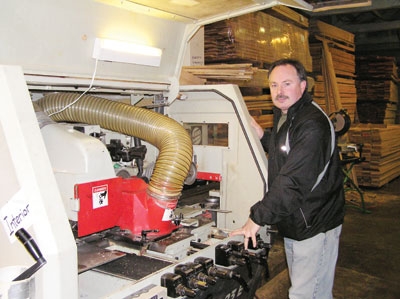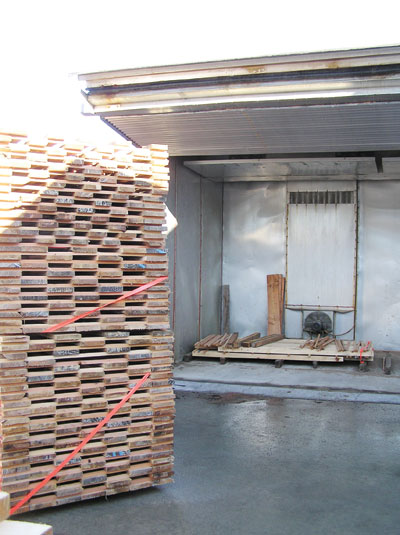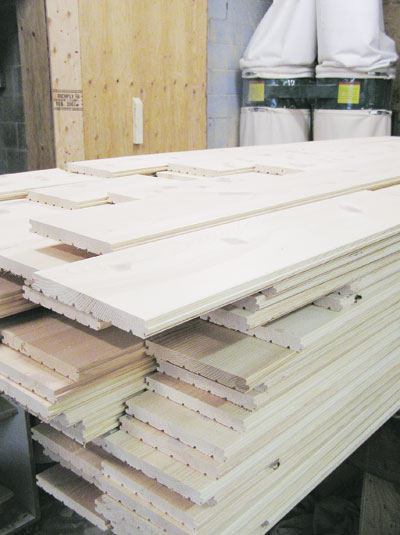
Features
Operation Reports
Remanufacturing
Flooring the Customers
As larger BC coastal mills close their doors, Steve Roscoe talks about a bright future, the potential for growth, and expanding his product line.
November 28, 2011 By Jean Sorensen
 GM Steve Roscoe at the Weinig Moulder As larger BC coastal mills close their doors
GM Steve Roscoe at the Weinig Moulder As larger BC coastal mills close their doors“We don’t see ourselves as a manufacturer, we are really a wood working shop,” he says of his 11-employee The Woodland Flooring Company Ltd. in Comox, on Vancouver Island. Over the past nine years, Steve, with wife Teresa Roscoe, plus a handful of shareholders, has carved out a million dollar niche in high-end flooring, and Woodland now enjoys a backlog of orders.
That the Roscoes are thriving – while larger entities are floundering – goes back to simple strategy. Roscoe began by questioning the whole value-added process. If adding value is the objective, why are BC primary and secondary mills not recouping the greatest value possible right from the stump through to the final product being shipped out to the consumer?
“From the moment you start to cut the tree, you begin to devalue it,” he says, adding that under those circumstances it makes sense to match the wood to the product and derive the greatest amount of high-end product possible. Simply shipping blanks, logs, or larger cuts out of the country makes little sense to Roscoe.
Roscoe’s operation strives for full value. He hunts for it at the woodlot and enhances it all along the processing path to ensure that value is accrued, not eroded. “We are keeping both the value and jobs in the community,” he says. Putting this strategy into play hasn’t been easy, and start-up was a tough slug for the Roscoes. They have had to break the mould on traditional thinking, establish and work with values that were sustainable yet returned a high-end product, and even initially design and build the equipment to run the flooring operation. It’s been a process of building the business literally from the floor up.
Started as End User
It started in the l990s with Roscoe working as a renovations carpenter using native woods at a local ski resort transforming its interior into one that exuded a warm, woodsy feel. It opened his eyes to the beautiful grained coloring of the native species, such as the honey-amber tones of the alder and maple, as well as the rich red and yellows of the cedar and fir.
Roscoe’s initial work lead to customers requesting specialty items, such as an alder or maple floor. They wanted the old-fashioned looking, wide planks that generously displayed the rich, tight-grains, swirled knots and wood tones. “The flooring market is huge,” tells Roscoe, but there was really nothing out there offering a 3.75 to 7 inch wide, all natural wood plank to consumers. Those old-style boards are commonly seen in many of Europe’s older buildings, early American homes, and in log homes.
Roscoe decided that a market opportunity existed. So in 1998, he put together a business plan for a venture that seemed limitless. There was only one slight problem. “The banks wouldn’t look at us,” chuckles Roscoe.
Salvation finally came in the form of the Community Futures Development Corp., a program that works with new innovative ventures within communities loaning up to $150,000 in start-up capital. The program supports new rural community ventures that are non-competing with other community businesses, use local resources, and provide community jobs.
The venture started out small. Roscoe built his first, second and third dry kiln himself, realizing that much of the kiln-dried wood from the standard mill simply wouldn’t suit his stringent needs. Only recently was he able to find a commercial model – Kiln-direct– which provides the flexibility required for smaller loads of diverse species. North Carolina’s Kiln-direct is a new kiln manufacturer catering to small to medium size value-added operations, as well as pallet makers, with designs by a Danish engineer now living in the US.
Drying and handling the wood has become an integral part of turning out a high-end product. Woodland needs to lower the moisture content (MC) to between 6 and 8%, which is substantially below the 14 to 18% found in most commodity lumber. Adding to the challenge, Roscoe is dealing with alder, a weed wood known for its handling problems as well as high MC. “We have worked with Forintek,” he says, crediting their help in providing drying solutions that lead to a quality product.
Roscoe maintains that in wide plank flooring, there are various stresses created within the board as it moves from the stage of being cut from the log or large cut to the finished product. Failure to dry the board properly and stabilize those stresses leads to warped or bowed boards that will not lie properly on the floor.

One of the features that the Kiln-direct kiln provides to high-end, value-conscious producers like Woodland Flooring is the ability to write a custom-program for each load. As well, sensors monitor the moisture content and heat within the load allowing on-line monitoring and corrections. Woodland’s unit is able to handle up to 8,000 bdft, is side-loaded for easy placement, and is gas-fired but features a heat-recovery system for vented moist air. The installation of the kiln has also reduced greenhouse gas emissions by 17%, Roscoe adds.
The solid planks or engineered wood product planks (which have a plywood backing) also come with very specific installation instructions. “Wide-plank flooring is a more technical product to work with than traditional wood flooring, requiring special attention to details regarding moisture and job site conditions,” he says.

The product does not compete with the common flooring found on market shelves. It is slightly more expensive than products offered by big-box suppliers, but it offers a quality look that comes from a hand-made product. “Our floor boards are wider, longer, environmentally-friendly and designed to last a century or more,” says Roscoe. He says the flooring has been shipped for installation in higher end homes from Whistler to Hollywood, plus venues such as the Walt Disney Concert Hall in Los Angeles.
Custom Cutting
The trees harvested must be able to yield wide planks and come from a certifiably sustainable source. Currently, four species are used: blue mountain pine (beetle kill wood), red alder, Pacific Coast maple and Douglas fir.
“We don’t mill any logs here,” says Roscoe. Rather, the larger cuts are re-sawn to meet the order file, but only after they are held in an external drying shed to allow the wood to air-dry. It then goes to the 32-in Kent resaw by conveyor to be broken down into either a half-inch or one-inch thickness. The half-inch boards are backed with three-quarter inch plywood for an engineered product for special uses. “The product can be used directly on concrete or in cottages which are not heated all year,” Roscoe says, with the plywood backing providing the stability to prevent warping of the floor.
After the resaw, the boards are left to air-dry. For alder, he’s devised a sticking system that helps prevent stick stain. Once through the Kiln-direct kiln, the material is again left to “relax” tells Roscoe. The boards are then processed; they move through a Weinig moulder, which makes the side tongue and grooves using replaceable special carbide index tools, eliminating the need for grinding. These replaceable units provide the highest quality, says Roscoe, adding that regrinding cutting heads can lead to “human error” that is quickly noticed when the boards have to fit snugly together.
Roscoe built the end-matcher, which places the tongue and groove on each end of the board. “We couldn’t find an end-matcher,” says Roscoe, voicing one of the frustrations of a smaller firm attempting to put together a value-added operation. The end-matcher was critical for another reason – by finishing the product on all sides, Woodland is able to avoid softwood lumber tariffs when shipping to the US.
Once through the moulder, the material goes into a chop line where staff manually chop out defects. The plant has one 10-in radial arm saw and two 12-in Dewalts. Only one is stationary, while two move throughout the production line as needed. The boards then flow into a two-headed Cantek belt sander before being hand-stained or distressed for an antique look.
The stained boards are left to dry again before moving into the final production stage, which is a revamped Italian coating machine applying a German-manufactured OSMO Poly-x hardwax oil, a combination of natural vegetable oils and waxes for a solid, zero VOC wood finish. Roscoe owns a subsidiary company, Raincoast Alternatives, that is now the Canadian distributor for OSMO Canada, and sells the hardwax to other flooring and wood manufacturers. Each shipment of wood flooring is packaged and sent out to the customer with a certificate of origin.
No Easy Street
Roscoe is the first to point out that the way his company operates is not the easiest route. He is constantly sourcing logs from woodlots and private operators, and he competes with peeler-grade wood.
“Right now we are having a problem finding beetle-kill pine (from BC interior woodlots),” he says, adding that larger mills are not interested in shipping half a container or can’t cut to his specifications. He’s also had to adopt a low-inventory policy to optimize the storage and production room in his small shop, and keep inventory costs in check. The shop and employees are both flexible. Employees do more than one job, and flexibility is designed into the flow of wood, so that custom orders can be dealt with quickly.
The operation is also proof positive that good environmental considerations can make sound business sense. By selling and buying locally or in Western Canada, Roscoe has reduced his trucking costs and the carbon emissions incurred in producing and shipping a product to customers. “Our objective next year is to be carbon neutral,” says Roscoe. Approximately 80% of the flooring is sold in western Canada, 10% goes to eastern Canada, and the remainder to the US. Such marginal US sales insulates the plant from currency fluctuations, and Roscoe feels that limiting exposure to markets is a good thing. He won’t let any one customer take more than 30% of his production, to avoid becoming vulnerable.
More importantly, Woodland has kept 11 employees working even in lean times. Roscoe is looking at expanding the shop from 7,000 square feet to 9,000 to provide a better showroom in 2008. He’s also aware that buyers want complementary products, such as windows and doors to match the floors, and he’s already producing stair components and wall mouldings.
One feature in the shop is a yellow cedar door made by an employee as a trial, and now installed in the shop. It’s symbolic of the future for Woodland Flooring, this golden door that opens up to new market opportunities and a bright future, when so many in the industry see nothing but storm clouds.
Print this page